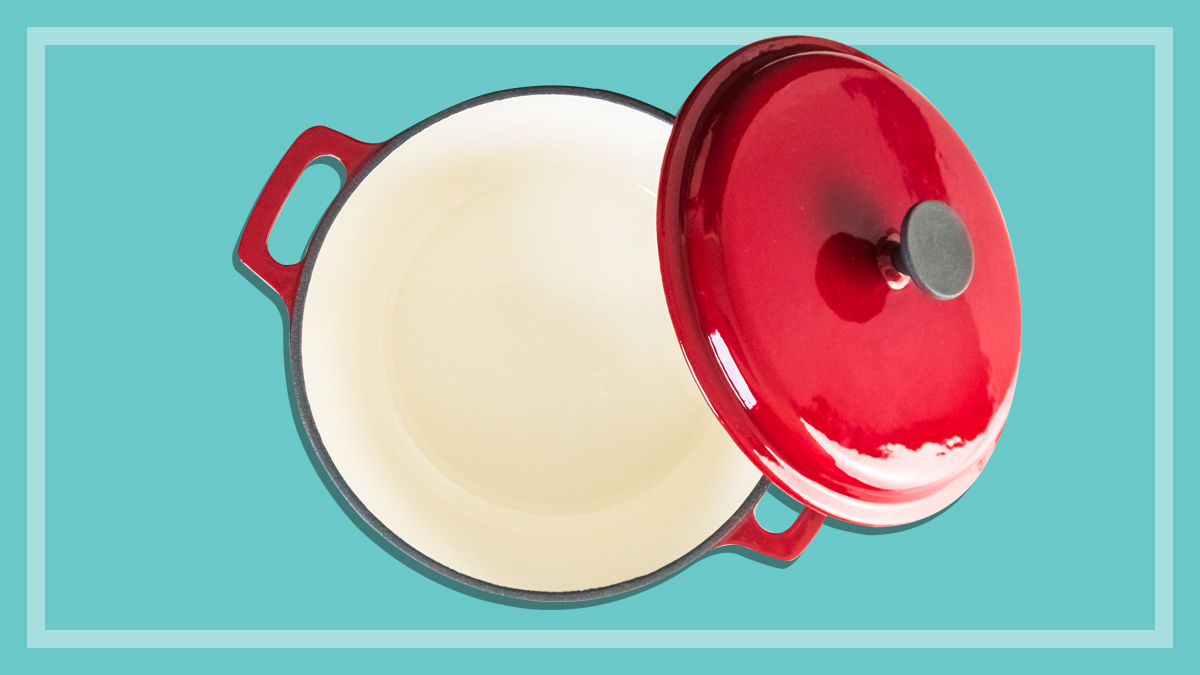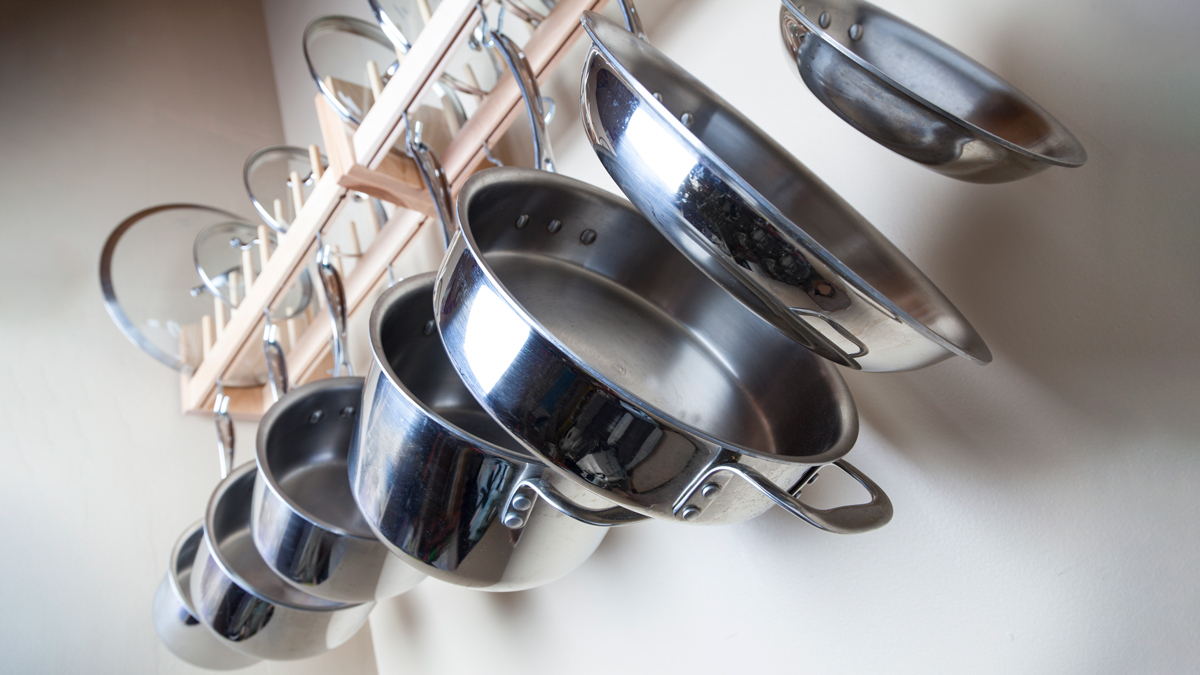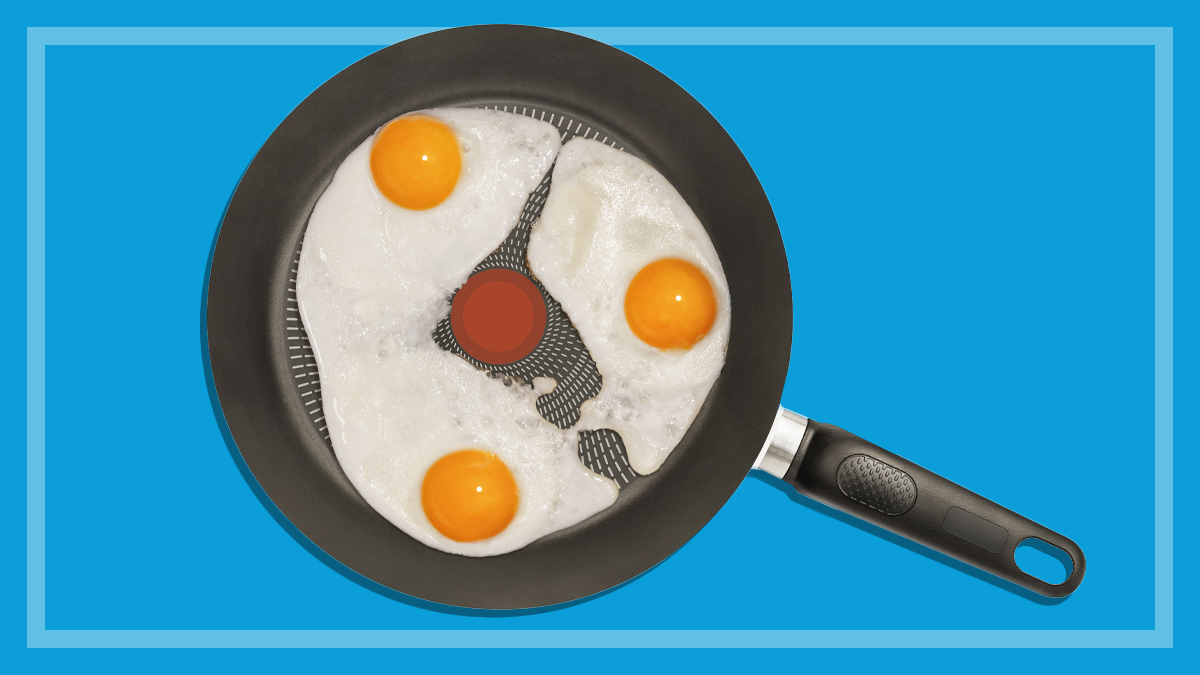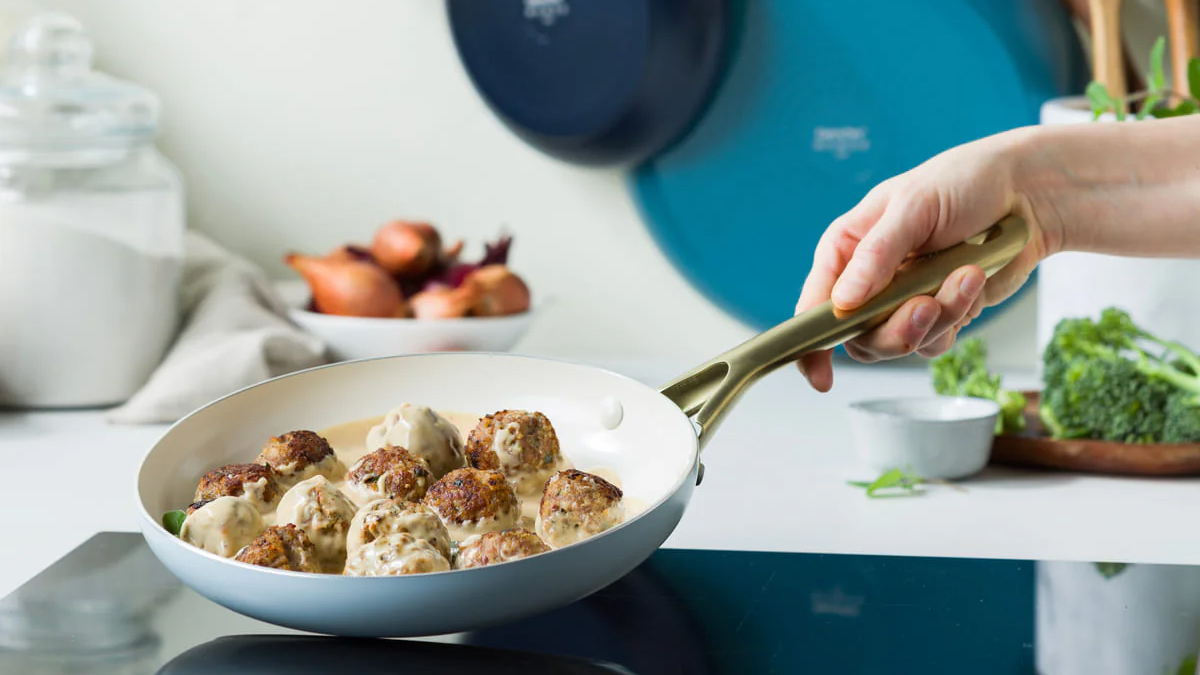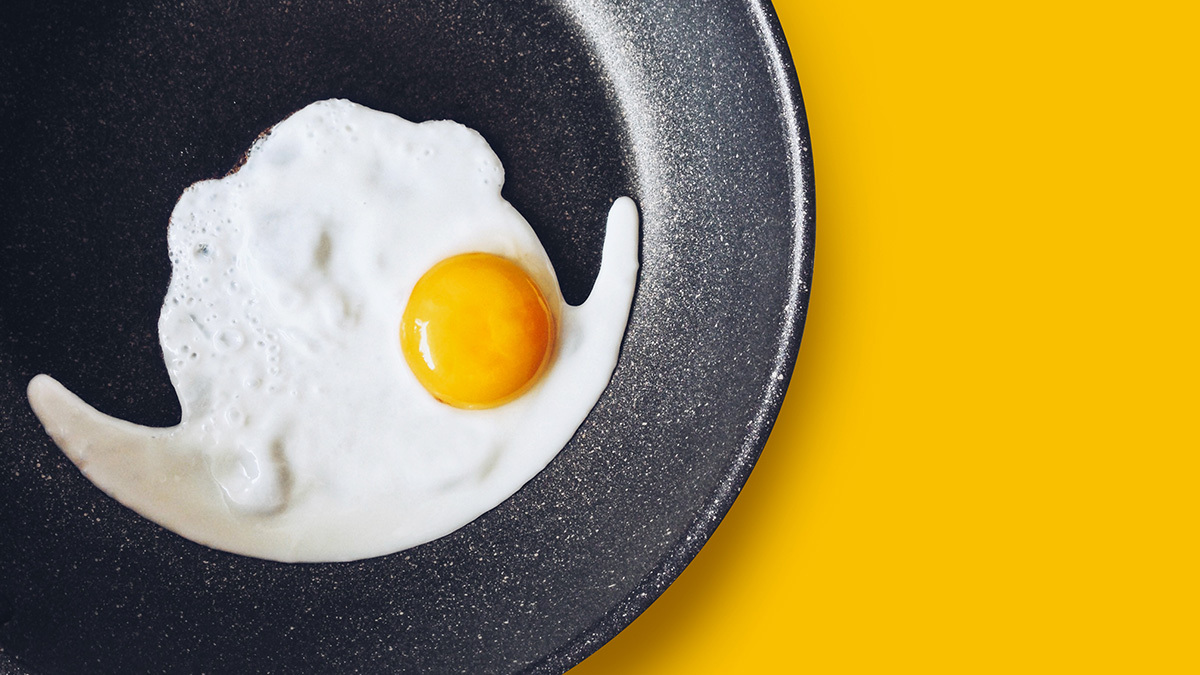Get our independent lab tests, expert reviews and honest advice.
Dutch ovens vs slow cookers: Which is best?
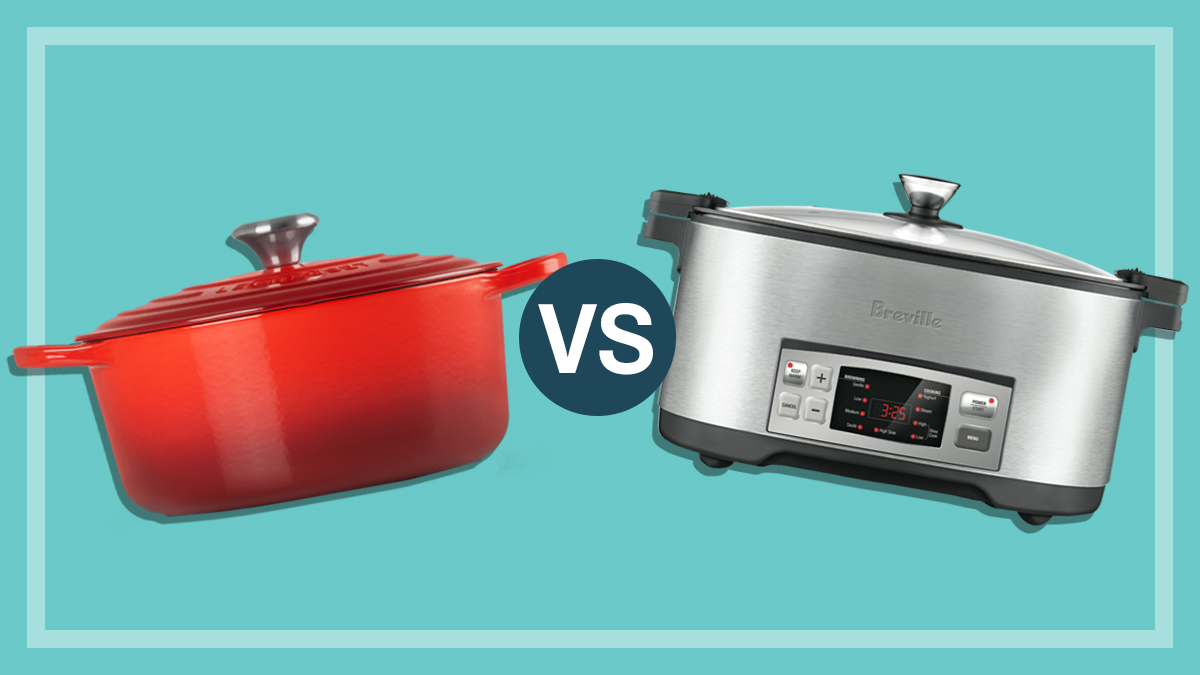
As the days get cooler and we start craving warming soups, comforting stews and rich casseroles, many of us will be reaching for our slow cookers or Dutch ovens.
I’m a huge fan of my slow cooker and I’m also the (somewhat sheepish) owner of four Le Creuset cast-iron pots collected over 20 or so years in various sizes, shapes and colours.
My slow cooker is a saviour for when I want to just bung a load of ingredients in the pot, turn it on, leave the house and come home to a delicious dinner that’s ready to go. And my cast-iron pots are brilliant for an array of cooking tasks, holding their heat and developing flavours exceptionally well.
But which delivers the best tasting slow-cooked dish? I cooked a simple lamb and rosemary stew simultaneously in my Breville slow cooker and Le Creuset cast-iron Dutch oven to compare results and see which one is the true star performer.
Benefits of cooking with a slow cooker
The ability to ‘set and forget’ is undoubtedly the drawcard of using a slow cooker. Because they cook food at a low temperature over an extended period of time, you can generally safely leave them to go about their business unattended. While I didn’t take advantage of this during my experiment, it’s important to note.
It’s also important to mention that my Breville slow cooker has a searing function, essential in my mind to avoid having to use an extra frying pan to sear and caramelise meat before cooking (and wash it up afterwards). Searing is an important step that adds oodles of flavour to your finished dish.
Slow cookers are also energy efficient and easy to use – I seared pieces of lamb shoulder in some oil in the pot, then reduced some red wine (still using the sear function), then added onion, vegetables, tomato paste, stock and rosemary and set it to slow-cook on high for five hours to mirror the cooking time of the Dutch oven.

Benefits of cooking with a Dutch oven
One of the pros of a Dutch oven is its ability to heat up evenly and quickly. This was something I forgot about when I left some oil to heat in my pot for a touch too long, causing it to spatter when I threw the lamb shoulder in and resulting in a nasty little burn on my arm (first human-error fail).
The meat seared more quickly and effectively in the Dutch oven than it did in the slow cooker and I was able to sauté the onions and reduce the wine a bit more effectively. Then, I followed the same process of adding in the vegetables, tomato paste and stock. I transferred the (heavy) pot to the oven, which I had preheated to 140°C, and set the timer for five hours to match my slow-cooker stew.
Pros of slow cookers
– set and forget
– useful functions
– no oven needed
– easy, safe and efficient
– relatively cheap to buy
Pros of Dutch ovens
– produce superior flavours
– excellent heat retention
– versatile for oven and stovetop
– extremely durable
– look great on display
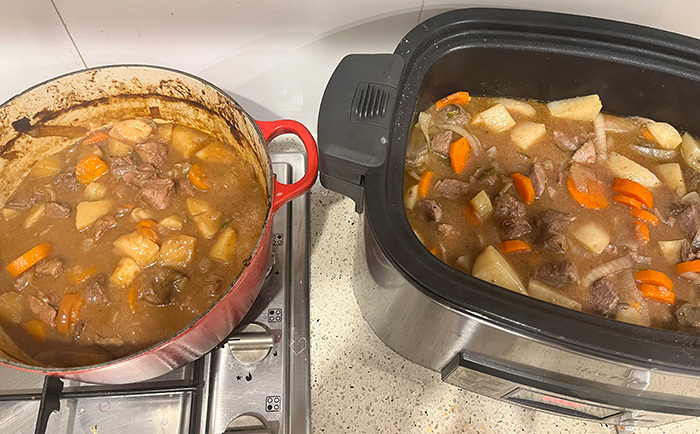
Five hours later: How the stews compared
As the delicious smells of cooking filled the house, my kids and husband started pestering me about when it was going to be ready. After I shooed a couple of whinging hungry family members out of the kitchen, I opened the lids of both dishes to compare.
Appearance
To me, the lamb stew cooked in the Dutch oven looked the more enticing of the two. There were those dark browned bits stuck to the side of the pot signifying some good flavour development had taken place, and the sauce looked more gravy-like, thickly coating the meat and vegetables which appeared to have cooked through well. You’ll never get that browning on the side of the pot in a slow cooker as the heat comes from the bottom element, rather than from all the sides and the top as it does with a Dutch oven.
Flavour
After a Masterchef-style, side-by-side taste-test performed by an “expert” panel comprising a Le Creuset-hoarding keen home cook (me), a discerning six-year-old and a hangry husband, the Dutch oven stew was declared the hands-down winner. It was richer and more complex, with sweet and savoury notes coming through in the unctuous sauce, and the vegetables and lamb were fall-apart tender.
The Dutch oven stew was declared the hands-down winner
The slow cooker lamb stew was still rich, aromatic and tasted great, but according to my discerning husband, it paled in comparison. The sauce was thinner, the flavours weren’t as developed and the vegetables were a little too firm. If I’m honest, it needed cooking for longer so I popped it back on low for another few hours (which would have caused a mutiny had I not had a back-up Dutch oven stew ready for dinner).
The expert take
CHOICE kitchen expert Fiona Mair has tested many slow cookers and Dutch ovens in our kitchen labs, so she knows exactly what to expect from each of these cooking methods.
“Both a Dutch oven and a slow cooker can be used to cook foods over a low heat for a long period of time. Both can give excellent results, but generally, dishes will taste better when cooked in a Dutch oven as opposed to a slow cooker,” says Fiona.
“This is because of the ability of a cast-iron pot to retain heat more effectively and a maintain consistent, even temperature that really helps flavours to concentrate and develop, and enables that rich caramelisation.”
Fiona says that part of the reason that food cooked in a slow cooker may taste more watery or have a thinner consistency is that during the cooking process, liquids or moisture that evaporates from the food will condense on the lid and drip back down into the food, rather than reducing and concentrating the flavour as would happen in a Dutch oven. This is why you generally have to add more liquid when cooking a slow cooker recipe in a cast-iron Dutch oven.
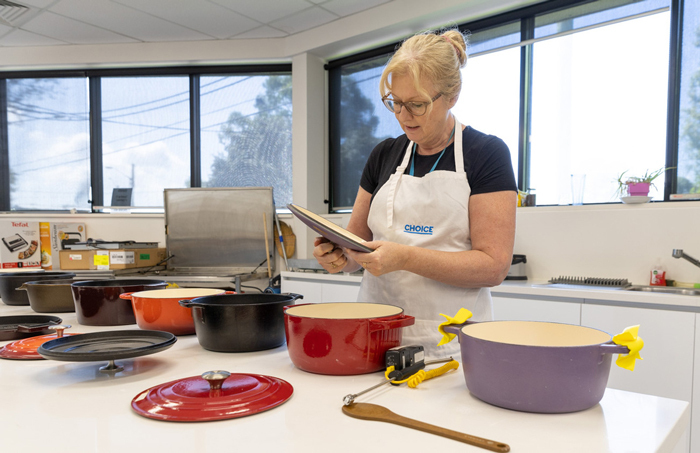
My novice verdict
I feel my hoarding of cast-iron pots has been vindicated! Even though cooking the slow cooker stew for a few hours longer improved the resulting flavour, the Dutch oven lamb stew was undeniably far superior and my cast-iron collection will now be my go-to for slow cooking when I know I’ll be home all afternoon.
I will continue to use my slow cooker, though, if I want to leave the house or cook overnight though (particularly as I have a handy ‘keep warm’ function on my Breville slow cooker so it doesn’t matter if I return home later than expected – it will turn itself off and keep our dinner warm until we get home).
Although some may be comfortable with leaving a cast-iron pot unattended in an oven at low temperatures, CHOICE experts advise that you should never leave an oven unattended.
Other things to consider: Slow cookers vs Dutch ovens
Although a great-tasting stew is a key sway factor, if you’re considering whether to invest in a slow cooker or a Dutch oven, there are a few other things to keep in mind.
Price and product reliability
As with most kitchen items, both slow cookers and Dutch ovens are available for a wide range of prices. CHOICE has tested Dutch ovens ranging in price from $30 for a Kmart pot up to $600+ for a premium cast-iron pot from brands such as Le Creuset or Staub, and slow cookers ranging in price from $24 up to $359.
A cheaper slow cooker is likely to have a shorter lifespan, which means it may end up in landfill while your Dutch oven is still happily sitting on your kitchen shelf
Premium cast-iron pots are undoubtedly pricey but they are also extremely durable and will last decades if you look after them, and many of the premium brands come with lifetime warranties.
They’re also recyclable. In contrast, there is always more chance of something going wrong with an electrical appliance, particularly those at the budget end of the scale. A cheaper standalone slow cooker is likely to have a shorter lifespan, which means it may end up in landfill while your Dutch oven is still happily sitting on your kitchen shelf (hopefully still turning out delicious stews).
Features
Different slow cooker models have a host of handy features that you might find useful, such as different heat settings, automatic timers and ‘keep warm’ functions.
Generally, the more features a slow cooker has, the more expensive it will be. However, even the most basic models are very energy efficient and can be used to cook a wide range of foods.
You can also now buy multi-cookers that have slow-cooking functions, which may be an option for you if you’re interested in an appliance that can also do things such as air frying, pressure cooking, rice cooking and more.
Versatility
A Dutch oven may just be a cast-iron pot but they’re incredibly versatile and suited to a wide range of cooking tasks (including baking bread!). They’re available in a huge range of colours and styles (both enamelled and non-coated), and you can use them on both the stovetop and the oven.
They can be extremely heavy though, and moving a cast-iron pot filled with food between a stovetop and oven can be dicey if you have limited mobility or struggle to lift heavy items.
Storage
Both slow cookers and cast-iron pots can be bulky to store, although Dutch ovens are arguably aesthetically pleasing enough to become a feature of your kitchen design or to go straight from oven to table (just don’t forget the heat mat and gloves!).

